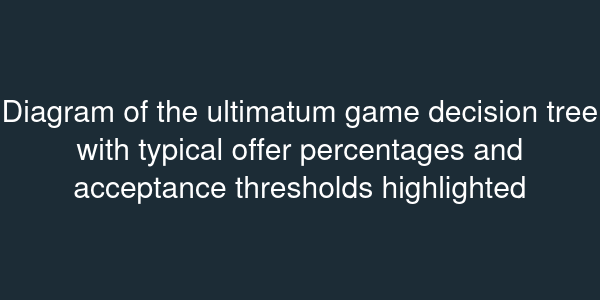Social Preferences
Essential Questions
- How do social preferences alter predictions from standard utility maximization?
- What do experiments like the ultimatum and dictator games reveal?
- How does the Fehr-Schmidt model quantify fairness concerns?
Overview
Imagine negotiating wages. Classical economics assumes each party maximizes monetary payoff. Yet in the ultimatum game, proposers offer 40–50% of the pie, and responders reject "unfair" low offers even at a cost to themselves. Social preferences—concerns about equity, reciprocity, and altruism—reshape incentives.
In this lesson, you will examine experimental evidence, derive utility functions that incorporate inequality aversion, and apply them to labor markets and public goods provision.
Experiments in Fairness
In the ultimatum game, Player A proposes a split of ; Player B accepts or rejects. If B rejects, both get zero. Rational self-interest predicts A offering and B accepting. Reality differs: average offers are around or , and offers below are often rejected. The dictator game (where B cannot reject) still yields offers of 20–30%, revealing altruism beyond fear of punishment.
Public goods games show conditional cooperation: contributions increase when others contribute. Gift-exchange experiments reveal workers increasing effort when employers offer higher wages even in the absence of enforcement.

Fehr-Schmidt Inequity Aversion
Fehr and Schmidt (1999) model utility as where is player 's monetary payoff, captures disutility from disadvantageous inequality, and from advantageous inequality. Typically . In the ultimatum game, a responder rejects an offer giving them if . With , offers below 40% of the pie are rejected, matching empirical data.
In labor markets, workers choose effort to maximize , where is a fairness benchmark. Employers anticipating inequity aversion offer higher wages to elicit effort, explaining above-market pay observed in firms with strong cultures.
Policy Implications
Social preferences justify redistribution in ways pure self-interest cannot. Tax compliance improves when individuals perceive funds support fair public goods. Punishment of norm violators in commons dilemmas sustains cooperation. In international negotiations, fairness narratives affect treaty compliance beyond material payoffs.
Designers of platforms, from crowdfunding sites to gig apps, use social features to trigger reciprocity and pro-social contributions. Recognizing social preferences helps you predict when market incentives alone fail and when community norms take over.